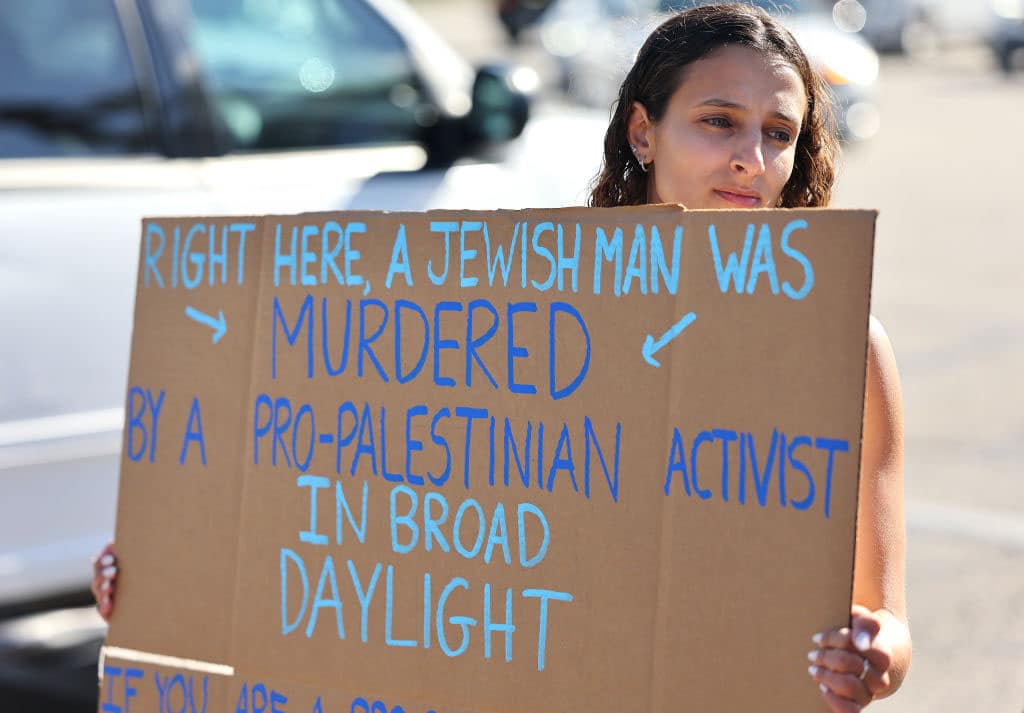Dozens of children (and their parents) flocked to The Jewish Federation of Greater Los Angeles building on a recent Sunday, drawn to a cheerful corner of the first floor where two performers led a tambourine-studded sing-along about barnyard animals.
Kids settled onto the carpet or their parents’ laps afterward as one performer, a young woman in bright clown makeup, read the story of “Jonah and the Whale.” The afternoon culminated in a “Yellow Submarine” dance party, as children accompanied the performers with toy whistles, trumpets, groggers and kazoos.
Sundays are known as family day at the Slavin Family Children’s Library. Throngs of local families gather at the cozy, colorful space for sing-alongs, story time, origami and the occasional holiday puppet party.
Tucked away past the security desk at the Federation’s Wilshire Boulevard headquarters, the Slavin Library was until recently a part of the former Jewish Community Library of Los Angeles. But it split off when the Federation closed the Community Library and merged its collection with American Jewish University’s (AJU) Jack M. and Bel Ostrow Library last year.
Since then, the Slavin Library has been quietly going about its business, a beacon of Jewish children’s literacy and family entertainment. But as the new year approaches, its future is uncertain.
The Slavin Library was funded by a grant from the Federation in 2010, but the agency still isn’t sure whether it will fund the library in 2011, according to Federation president Jay Sanderson.
“It hasn’t been utilized by the community in the way that we had hoped,” Sanderson said recently.
Getting families from far-flung neighborhoods to take advantage of the library has been challenging, he said. “There is not a tremendous number of young families that live in the general vicinity. If you live in Calabasas, are you going to drive to 6505 Wilshire Blvd. every week? Probably not,” he added.
Most of the Slavin’s 500 to 600 weekly visitors return regularly for ongoing programs such as “Book Time With Your Baby,” said Amy Muscoplat, one of the repository’s two professional librarians. Among the 10,000 items in circulation are books, CDs, DVDs and Jewish-themed computer games including “Shuki” and “Alef-Bet Adventure.”
Parents can check out tomes on arts and crafts for kids, family education, raising moral children and Jewish cookbooks. One wall offers inspirational books and films. For kids, there are colorful stacks of books on the Jewish holidays, Israel and Bible stories — some even in graphic-novel style.
David and Rachel Shirazi, of Beverly Hills, like to bring their infant and their 3-year-old to the library for the Sunday programs. “They have great books and CDs for parents, and the kids come here and have a good time,” David said.
“It’s introducing children to music, dance, reading,” added Rachel. “Education starts here, in a library.”
That’s been the Slavin Library’s philosophy since it opened in 2000. Under the umbrella of the Jewish Community Library, which the Federation founded and has run since 1947, the Slavin Library has held programs and circulated books to thousands of L.A.-area children. At 10 years old, Slavin is still the only free, public Jewish children’s library in Southern California, Muscoplat said.
Federation officials had said the Slavin Library would remain untouched in its current location after signing the deal to merge the Community Library collection into AJU last summer. The deal was signed amid vocal opposition from Community Library patrons calling for an independent library to be set up in a more accessible locale than AJU’s hilltop campus off Mulholland Drive.
The Federation had been cutting funds allocated to BJE (Builders of Jewish Education) to run its libraries for years. In 2008, just as a BJE task force was struggling to map out the future of the Community Library, AJU president Robert Wexler proposed a plan to absorb the books into an expanded public library housed at the university.
AJU’s Ostrow Library took in about 6,000 volumes from the former Community Library’s 30,000-volume collection, Wexler said recently. Many of the rest were duplicates and some had already been gleaned by the BJE staff for its own internal library, he added. An extensive trove of community archives was handed over to the Jewish Historical Society of Southern California.
The Community Library books became available at AJU in December 2009, bringing the Ostrow Library’s collection to 110,000 volumes. And patrons have been responding.
Circulation is up 10 percent since the Community Library merger, Wexler said. Ostrow Library also has 325 new patrons since last year — 40 percent of whom are public users, not clergy or students. Around the same time AJU acquired the Community Library volumes, the Ostrow Library stopped charging a fee for public borrowers.
The university is now raising funds to build a larger facility to house its expanded collection, which would double the space currently available for stacks, display areas and reading lounges. The new, nearly 20,000-square-foot quarters would be Wi-Fi equipped and feature event areas for visiting authors and other programs to get more community members in the door, Wexler said. AJU now has about half the $8 million needed for the project.
Overall, the Community Library merger still feels like the right move, Wexler added.
“We’re very pleased with the way it has gone, and people will really feel a difference when we have the new facility,” he said.
Meanwhile, the Slavin librarians don’t know what will become of the children’s collection if they don’t get funding next year to hold onto their Wilshire Boulevard space. The Federation supported the Slavin Library with a grant of about $75,000 in 2010.
The library is utilized not only by local Jewish families, Muscoplat said, but also as a resource for Jewish day school and Hebrew school teachers.
“There’s a real sense of community here,” she said. “Moms and dads and nannies all get to know each other, and children make new friends.”
Federation committees are still weighing different ways to engage young families in 2011, according to Sanderson.
One of those options is expanding a partnership with the PJ Library program, which sends Jewish children’s books and music to families by mail. The Federation is already offering that program to families in the San Fernando Valley. Sending out books by mail makes more sense than asking people to brave dense Westside traffic to reach one central location, Sanderson said.
“We’re constantly looking at the programs we’re doing based on the needs of the community,” he said.






















 More news and opinions than at a Shabbat dinner, right in your inbox.
More news and opinions than at a Shabbat dinner, right in your inbox.